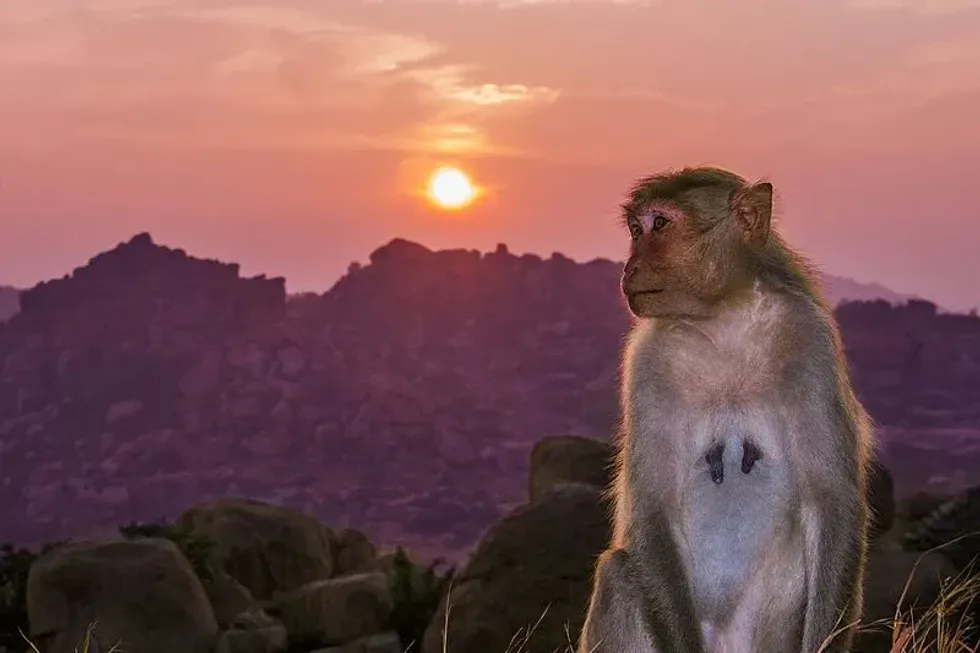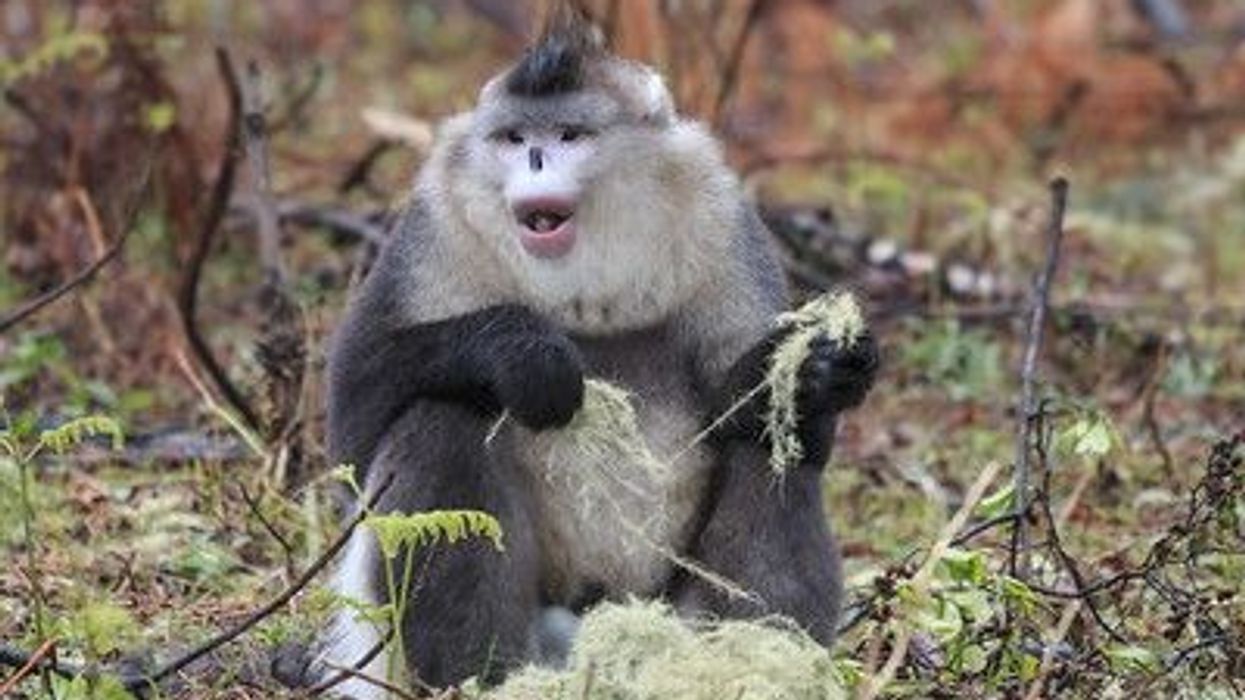The rhesus macaque (Macaca mulatta), popularly called the rhesus monkey, is a species of Old World monkey. They have the widest known geographic range of all non-human primate species, found widely across entire central, south, and southeast Asia, which is also its native place.
They are alternatively found along with southern China, northern India, Bangladesh, Pakistan, and Nepal. These macaques are brown to gray in color with pink faces and a long tail.
They are very closely related to humans. These monkeys have an average lifespan of about 30 years in the wild, and when kept in captivity, it can be increased further.
Rhesus macaques are herbivores, and their usual diet includes fruits, seeds, and other plant parts.
Also, rhesus monkeys are very social animals and therefore are mostly found living in groups of 2-20 other rhesus monkeys. Rhesus monkeys are average-sized mammals, and the females are a little smaller in size than males.
Their sexual behavior is polyandrous, which implies that the males and females mate with multiple partners during the breeding season to give birth to one single infant. However, the breeding season varies widely among the populations.
Here, we have many amazing and interesting facts about rhesus monkeys that you will enjoy. So let's take a look at these facts and information, and if you enjoy these, do also read our Diana monkey facts and black spider monkey facts.
Rhesus Monkey Interesting Facts
What type of animal is a rhesus monkey?
Rhesus monkeys (Macaca mulatta) are a species of Old World monkeys that are native to South, Central, and East Asia. This primate has the widest geographic range among all non-human primates.
Their population distribution is widely focussed in northern India, western and eastern parts of Asia, including; China, Pakistan, Burma, Nepal, and Vietnam. Rhesus monkeys are brown to gray in color with pink faces and a long, hairy tail.
This species of rhesus monkeys are very social animals that are mostly found in groups of 2-20 similar rhesus monkeys.
Their breeding season lasts all year long and is highly dependent on their population distribution range. However, this species is polygamous in behavior which implies that both males and females have multiple partners.
What class of animal does a rhesus monkey belong to?
Rhesus macaques (Macaca mulatta) belong to the class Mammalia.
How many rhesus monkeys are there in the world?
The exact estimate of the total population of rhesus macaque is yet not known but their conservation status is Least Concern as per the IUCN Red List which implies that these rhesus macaques are present in vast numbers in the world, and that these macaques are free from any immediate danger or threat.
Where does a rhesus monkey live?
Populaces of rhesus macaques (Macaca mulatta) are native to Asia and most commonly found in northern Thailand, western Afghanistan, and India. This species of macaques are also popular in southern and eastern China and Tibet.
However, people have caused extraordinary decay of populaces here in the course of the last few decades. Since rhesus macaques are used extensively for research, they are kept in captivity all around the world.
What is a rhesus monkey's habitat?
Rhesus macaques (Macaca mulatta) are wild animals that live in the wilderness. They are also found in close proximity to open forestlands, woodlands, and jungles.
However, these rhesus macaques show a great deal of adaptability in behavior when choosing their living space. These primates can acclimate to an assortment of climatic limits, from blistering, dry temperatures found in deserts to cold winter temperatures which are cold enough to freeze humans.
Who do rhesus monkeys live with?
Rhesus macaques (Macaca mulatta) are exceptionally energetic and active. They live in groups of up to 200 similar rhesus macaques, and at the point when a groups' size arrives at 80-100 individuals, a sub-group of females may separate to form another group.
Groups, for the most part, comprise a couple of random males and numerous closely related females. Now and then, little groups are formed that comprise just males.
Males, for the most part, leave the group where after they are conceived and shortly after, they arrive at sexual maturity. The two males and females in a group show an inclination for dominance from the other gender.
Dominance systems exist in both sexes, but it is undeniably more obvious in males, where rivalry for mates can become violent. The female individuals from a group and generally live in complete congruity and seldom have any fights with each other. Despite the fact that rhesus macaques live in groups, they are not at all territorial in behavior.
How long does a rhesus monkey live?
The average life span of rhesus macaques (Macaca mulatta) is 30 years, but when kept in captivity, it can be increased even more with a proper diet and in the absence of any disease.
How do they reproduce?
Rhesus macaques (Macaca mulatta) are polygamous in behavior when it comes to mating, which implies that during the breeding season, male rhesus and female rhesus have various mating partners. The breeding seasons shift broadly among the populace and are largely dependent on climatic conditions as well.
Monkeys living in regions with cold winters mate in the fall, and those living where there are less articulated occasional changes have less obvious seasons for mating.
The gestation period lasts for about 165 days, and normally a solitary infant is conceived per year after the gestation period.
Young ones usually stay with their mother for about a year and depend completely upon them for their diet and other needs. Female macaque usually reaches sexual maturity at two to three years of age, while male macaque acquires the same at four to seven years of age.
What is their conservation status?
The conservation status of this species of macaque is Least Concern, as per the IUCN Red List. However, this species of macaques are often kept in captivity as they are used in scientific research and other medicinal activities that have put their entire populations at a high risk of being Endangered.
Rhesus Monkey Fun Facts
What do rhesus monkeys look like?

Macaca mulatta (Rhesus macaque) is a macaque of the Old World species. They are pale brown to gray in color, with a pink face.
Their tails are very long, and they have a rib confine that is more extensive than normal as compared to other primates, with dorsal scapulae, and they have 32 teeth. They are appealing monkeys and like to have a great time and can be a bit loud. Their coats have worn-out undertones on the underside.
Adult rhesus macaque has a furless face that is dazzling red in color, and the adult rhesus also has a radiant red backside. Apart from that, adult monkeys also have enormous cheek pockets for putting away food while out scavenging.
How cute are they?
Macaca mulatta (rhesus macaque) are cute small animals with the young monkeys being cuter than the adult ones. This animal is extremely active and energetic and therefore should be admired from a distance as it might cause harm to humans if they are threatened.
How do they communicate?
The communication process of the rhesus macaque, just like all other monkeys, includes an assortment of visual signs, body stances, facial expressions, vocalizations, and fragrance cues. Grooming, fighting, and playing are also some of the communication tactics that the rhesus macaque opts to use to communicate with others.
How big is a rhesus monkey?
The length of the rhesus macaque falls in the range of 18.5-20.8 in (47-53 cm). Rhesus monkeys are a bit smaller in length than the gray langurs, and the males are a bit larger than the females.
How fast can a rhesus monkey jump?
The exact speed of the rhesus macaque is yet not known, but this species is known to be extremely fast and agile when it comes to activities like jumping and running.
How much does a rhesus monkey weigh?
The weight of an adult rhesus falls in the range of 11.6-16.9 lbs (5.3-7.7 kg) which is a little less than the weight of an adult gray langur.
What are the male and female names of the species?
The males and females of this species do not bear any special name.
What would you call a baby rhesus monkey?
A baby rhesus is known as an infant.
What do they eat?
The diet of choice for rhesus monkeys can fluctuate incredibly depending on where they reside. They are mostly herbivorous in nature, and the diet of the adults depends primarily on roots and fruits, whereas the young ones prefer a diet of fruit and milk from their mother.
Their eating regimen likewise fluctuates with the season, and these macaques appear to pick their surroundings cautiously as per their food requirements, most of the time near water sources like a river or lake.
How active are they?
These monkeys are extremely active and energetic. They keep hopping and jumping from one tree to another, spending most of their days on the trees and less time on the ground.
Would they make a good pet?
They could technically be kept in captivity as pets, but this would not be recommended as it is harmful to their well-being. Like all other animals (humans included!), they have the right to be in the healthiest environment possible for their well being which is usually in forests and woodlands.
Did you know...
In 1938, a free-ranging colony of rhesus macaques was established on a Caribbean island near Florida.
Rhesus monkeys are the closest nonhuman primates to humans, and therefore, scientists who research vaccines typically use these monkeys in trials for their research.
Some interesting animals similar to this monkey are the saki monkey and the drill monkey.
Do rhesus monkeys eat meat?
The rhesus monkey is mostly a herbivorous primate, but at times, it feeds on a meat-based diet too, which mainly includes small animals and insects.
How much DNA do we share with rhesus monkeys?
According to research conducted by International Consortium, humans are reported to share 93% of their DNA with rhesus macaques.
Here at Kidadl, we have carefully created lots of interesting family-friendly animal facts for everyone to discover! Learn more about some other mammals from our hoolock gibbon facts and brush rabbit facts pages.
You can even occupy yourself at home by coloring one on our free printable rhesus monkey coloring pages.










